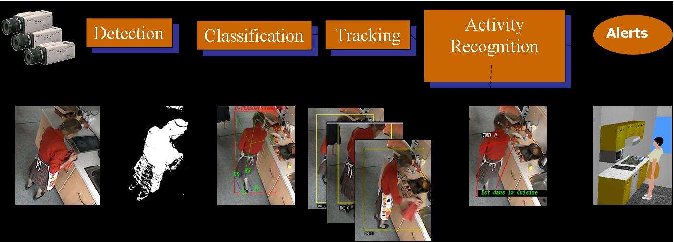Section: New Results
SUP
Participants : Julien Gueytat, François Brémond.
keywords: SUP, Software, Video Processing
Presentation
SUP is a Scene Understanding Software Platform writtent in C++ designed for analyzing video content. (see Figure 44 ) SUP is splitting the workflow into several modules, such as acquisition, segmentation, etc., up to activity recognition. Each module has a specific interface, and different plugins implementing these interfaces can be used for each step of the video processing.
The plugins cover the following research topics:
-
algorithms : 2D/3D mobile object detection, camera calibration, reference image updating, 2D/3D mobile object classification, sensor fusion, 3D mobile object classification into physical objects (individual, group of individuals, crowd), posture detection, frame to frame tracking, long-term tracking of individuals, groups of people or crowd, global tacking, basic event detection (for example entering a zone, falling...), human behaviour recognition (for example vandalism, fighting,...) and event fusion;
-
languages : scenario description, empty 3D scene model description, video processing and understanding operator description;
-
knowledge bases : scenario models and empty 3D scene models;
-
algorithms of 2D & 3D visualisation of simulated temporal scenes and of real scene interpretation results;
-
algorithms for evaluation of object detection, tracking and event recognition;
-
learning techniques for event detection and human behaviour recognition;
-
algorithms for image acquisition (RGB and RGBD cameras) and storage;
The software is already widely disseminated among researchers, universities, and companies:
-
Nice University (Informatique Signaux et Systèmes de Sophia), University of Paris Est Créteil (UPEC - LISSI-EA 3956)
-
European partners: Lulea University of Technology, Dublin City University,...
-
Industrial partners: Toyota, LinkCareServices, Digital Barriers
And new sites are coming: EHPAD Valrose, Institut Claude Pompidou, Delvalle and Biot.
Improvements
Our team focuses on developing a Scene Understanding Platform (SUP). This platform has been designed for analyzing video content. SUP is able to recognize events such as 'falling', 'walking' of a person. We can easily build new analyzing systems thanks to a set of algorithms also called plugins. The order of those plugins and their parameters can be changed at run time and the result visualized on a dedicated GUI. This platform has many more advantages such as easy serialization to save and replay a scene, portability to Mac, Windows or Linux, and easy deployment to quickly setup an experimentation anywhere. All those advantages are available since we are working together with the Inria software developer team SED. Many Inria teams are pushing together to improve a common Inria development toolkit DTK. Our SUP framework is one of the DTK-like framework developed at Inria.
Currently, the OpenCV library is fully integrated with SUP. OpenCV provides standardized dataypes, a lot of video analysis algorhithms and an easy access to OpenNI sensors such as the Kinect or the ASUS Xtion PRO LIVE.
Updates and presentations of our framework can be found on our team website https://team.inria.fr/stars/software . Detailed tips for users are given on our Wiki website http://wiki.inria.fr/stars and sources are hosted thanks to the software developer team SED.


